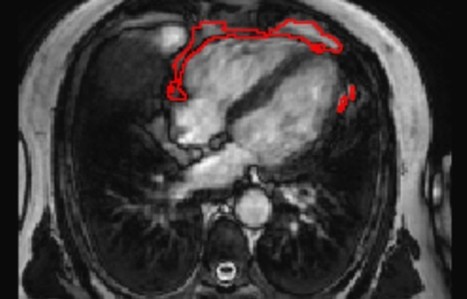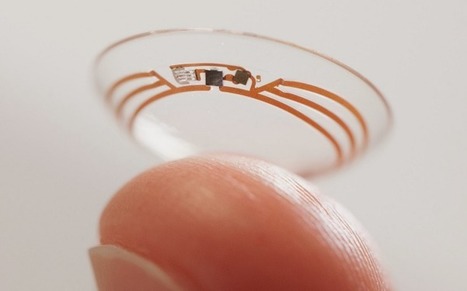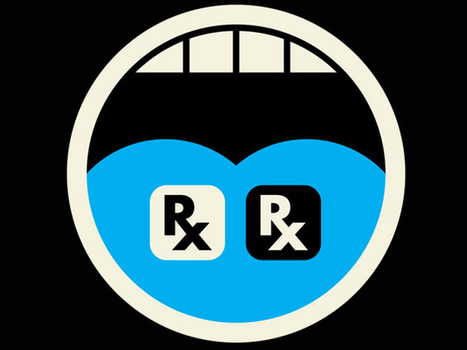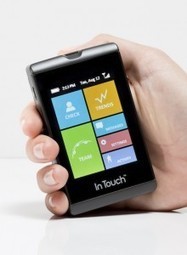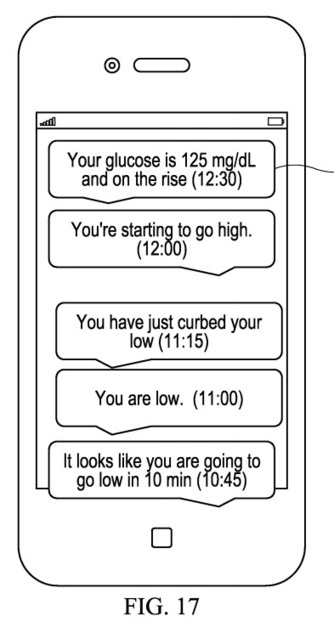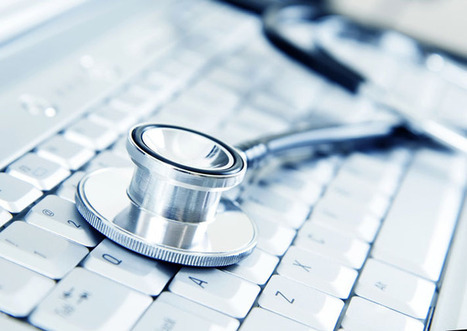 Your new post is loading...
 Your new post is loading...

|
Scooped by
nrip
|
The distribution of fat in the body can influence a person's risk of developing various diseases. The commonly used measure of body mass index (BMI) mostly reflects fat accumulation under the skin, rather than around the internal organs. In particular, there are suggestions that fat accumulation around the heart may be a predictor of heart disease, and has been linked to a range of conditions, including atrial fibrillation, diabetes, and coronary artery disease. A team led by researchers from Queen Mary University of London has developed a new artificial intelligence (AI) tool that is able to automatically measure the amount of fat around the heart from MRI scan images. Using the new tool, the team was able to show that a larger amount of fat around the heart is associated with significantly greater odds of diabetes, independent of a person's age, sex, and body mass index. The research team invented an AI tool that can be applied to standard heart MRI scans to obtain a measure of the fat around the heart automatically and quickly, in under three seconds. This tool can be used by future researchers to discover more about the links between the fat around the heart and disease risk, but also potentially in the future, as part of a patient's standard care in hospital. The research team tested the AI algorithm's ability to interpret images from heart MRI scans of more than 45,000 people, including participants in the UK Biobank, a database of health information from over half a million participants from across the UK. The team found that the AI tool was accurately able to determine the amount of fat around the heart in those images, and it was also able to calculate a patient's risk of diabetes read the research published at https://www.frontiersin.org/articles/10.3389/fcvm.2021.677574/full read more at https://www.sciencedaily.com/releases/2021/07/210707112427.htm also at the QMUL website https://www.qmul.ac.uk/media/news/2021/smd/ai-predicts-diabetes-risk-by-measuring-fat-around-the-heart-.html

|
Scooped by
nrip
|
After an initial diagnosis, diabetes sufferers often experience a period of shock when they learn that everything has to change. Turkish mobile operator, Turkcell, and agency R/GA London have created an app to make adjusting to the necessary life changes much easier.
Instead of trying to persuade sufferers to adopt entirely new habits, tools and behaviors to monitor the condition, "healthmetre" deploys Instragram, a tool many people already use and taps into behaviors that people already have.
R/GA designed healthmetre to be a more human way to manage diabetes and help patients develop new, more healthy habits in a way that feels natural and thereby, helping them reach a level of consistency.
The idea is to make using the app as simple as possible, helping people stay motivated, complying with treatment and keeping the lines of communication with medical staff open.
Diabetes is an increasing problem across the world and Turkey has been particularly affected. The most recent statistics (2014) from the International Diabetes Federation show that Turkey has the highest rate of the illness in Europe, with an incidence of 14.7%, much higher than countries like, for example, the U.K. (5.4%) or mid-ranked Germany (7.9%).
The results of the 18-month trial are highly encouraging. Treatment compliance increased by 54%. Blood sugar levels decreased by 27% and complication forecasts decreased by 37%.
more at http://www.fastcocreate.com/3047389/a-new-app-to-make-life-easier-for-diabetics-using-instagram

|
Scooped by
nrip
|
Finger pricks and careful eating are an important part of the daily routine for most people with diabetes. While automated glucose meters are a growing option, they can still create discomfort and other inconveniences.
Google wants to go in a totally different direction with a project announced today:smart contact lenses that can detect glucose levels via the wearer’s tears and alert them when levels dip or rise.
This isn’t the first smart contact lens, and several options already exist for people interested in monitoring glaucoma. But Babak Parviz, who also leads the Google Glass team, is a smart contact pioneer and Google which is a secretive division of Google dedicated to difficult, future-looking projects, has a reputation for ably pursuing projects like this.
The lens works via a small wireless chip and glucose sensor embedded between two pieces of soft material. The current prototype puts out a reading once a second. Google is also interested in integrating an LED light, which could light up to alert the wearer of dangerous glucose levels.
The lab is now looking for parters to help bring the lens to market. It would also like to develop an app that would help wearers read and manage the data the lens takes in.
The lens could help people with diabetes monitor their daily health and recognize dangerous situations.
more at http://gigaom.com/2014/01/16/google-testing-contact-lens-that-can-monitor-glucose-levels/

|
Scooped by
nrip
|
This year, when patients throughout the United States begin downloading the world’s first doctor-prescribed smartphone app, mobile health care will finally get what big-time medicine most requires: a way to get insurance companies to pay for it.
The app, called BlueStar, helps people with Type 2 diabetes (the most common kind) by suggesting, in real time, when to test their blood sugar and how to control it by varying medication, food, and exercise. That it requires a physician’s prescription is actually an advantage, because it means insurance companies will reimburse BlueStar’s fee.
“This is a piece of software getting the same treatment as a medical device,” says Sonny Vu, cofounder of Misfit Wearables in San Francisco, a maker of wearable computing devices. “It’s pretty world-changing.”
The U.S. Food and Drug Administration cleared BlueStar for market in 2010, in line with its recent determination to regulate devices that provide a diagnosis or recommend a treatment, not those that simply track activity, like calories consumed or steps taken. The success that WellDoc, the app’s manufacturer, has had with the FDA may inspire other mobile health companies to go the regulatory route. “It gives us hope that you can pull something like this off,” says Vu. The European Commission has also issued guidance on regulations for mobile health apps, but countries such as China and India have not.
The app addresses one of the toughest tasks a physician has: changing patient behavior.
Doctors ask diabetic patients to keep a daily record of glucose readings, food, exercise, and medications. If managed well, these factors keep patients’ blood sugar in a safe range, reducing their risk of complications from the disease. But only 15 to 20 percent of patients actually keep a log, says Philis-Tsimikas.
Diabetes apps that make activity tracking easier are available, but their effectiveness is limited. “No one does it, because you have to wait 90 days before you get feedback [at your next doctor visit],”

|
Scooped by
nrip
|
The sensors could survive for a year in the human body, which is longer than any previous sensor.
Science has produced a range of nanomaterials in recent years with abilities that are highly useful to human health, including screening for toxins and monitoring levels of vital chemicals. But before the materials can be useful, it has to be possible to insert them into the body without the immune system attacking and destroying them.
MIT researchers published a paper (subscription required) this week describingsensors they created that could last in the human body for up to a year. The nanosensors are the first to have the ability to survive for such a long time.
The sensors are made from carbon nanotubes—minute tubes of rolled-up sheets of carbon atoms measuring just an atom thick. Carbon sheets are good at capturing individual molecules , which makes them excellent sensors. The researchers found that when they combined the nanotubes with different molecules, they could detect specific chemicals implicated in human health.
The first sensor the researchers built detects nitric oxide, which may play a role in cancer development. Using nanotubes to detect it could provide more information on the role NO plays in healthy vs. cancerous cells. The researchers are also interested in developing a sensor that detects glucose levels, which could be implanted in a diabetic patient’s body and provide a finger-prick-free system to monitor glucose and insulin levels.
So far, the researchers have tested the sensor under mice’s skin, where it worked for 400 days. While the body generally rejects foreign objects by pushing them out through the skin, the sensor was wrapped in an algae-based plastic gel that protected it from the body’s immune system.
Eventually, the researchers think similar sensors could be used to monitor inflammation and pick up on a person’s body rejecting an implanted device.
|

|
Scooped by
nrip
|
IBM Watson Health is teaming with the American Diabetes Association to apply cognitive computing to the ADA's 66 years worth of research and data. The results will be used to help entrepreneurs, developers, healthcare providers, and patients learn more about diabetes, prevention, complications, and care In 2012, according to the ADA, 29 million people were living with the disease, and another 86 million were diagnosed with a condition known as prediabetes. To address the challenge, IBM Watson Health and the ADA are collaborating to apply Watson cognitive computing to the organization's massive library of information and data. Through this effort, IBM and ADA hope to empower entrepreneurs, developers, healthcare providers, and patients to gain knowledge that can improve outcomes and even prevent the condition's onset. First, IBM's AI platform will ingest all the medical journals, medical text books, Pub Med, and other diabetes literature and resources available, including all the content from the ADA's Diabetes Information Center. Second, Watson will ingest the ADA's diabetes data sets. Watson will be trained to understand the diabetes data to identify potential risk factors and create evidence-based insights that can be applied to health decisions. IBM also is collaborating with the Health Maintenance Organization Maccabi Healthcare services to build a predictive machine learning model to help identify early risks for diabetic retinopathy, the top cause of blindness for those with diabetes.

|
Scooped by
nrip
|
New survey data from digital health agency Klick Health shows that diabetes patients who use digital tools to manage their health also feel healthier.
Klick Health employed Survey Sampling International (SSI) to poll 2,000 American adults with diabetes either online or via the telephone.
Based on responses about how they use technology to manage their health, they segmented the group into three categories: those who manage their health daily or weekly with integrated digital technologies (integrators), those who go online to seek health information on a monthly basis (seekers), and those who don’t use the internet to manage their health at all (traditionalists).
The integrators group, the true digital health users, made up just 18 percent of the sample, but 13 percent of integrators reported being in excellent health. Seekers made up 47 percent of the sample and 4 percent of seekers said they were in excellent health. Finally, the remaining 35 percent were traditionalists, and only 2 percent of that group reported being in excellent health.
Because it’s a survey based on self-reported health status, the data doesn’t prove that connected patients are actually healthier than non-connected patients. But it does provide evidence that either they’re healthier or they believe they’re healthier, which is significant in and of itself. Nineteen percent of patients reported using mobile technology for a health-related activity. Of these, most wanted more data-driven interactions with their doctors. Two-thirds said they would like an app to remind them to take their medication, 75 percent wanted apps to connect them with their doctors, and 78 percent were open to sharing personally-collected health data with their doctors.
Overall, 80 percent of the mobile connected group were interested in having an app recommended to them by their doctor.
more at http://mobihealthnews.com/40600/survey-diabetes-patients-who-use-digital-tools-self-report-better-health/

|
Scooped by
nrip
|
San Diego-based Dexcom, a maker of continuous glucose monitors, has filed for a patent for a system that would integrate a smartphone with a Dexcom device, detailing some of the features such a device might have.
“The present embodiments harness a wide variety of capabilities of modern smartphones, and combine these capabilities with information from a continuous glucose monitor to provide diabetics and related people with more information than the continuous glucose monitor can provide by itself,” the patent application reads. “The increased information provides the diabetic with an increased likelihood of good diabetes management for better health.”
The patent is focused particularly on a “continuous analyte monitor”, and describes how continuous monitoring could connect with a phone’s built-in activity monitor, GPS, scheduling systems, contacts, camera, and voice activation.
Much of the functionality described in the patent has to do with collecting continuous blood sugar data and other data — like activity and location — simultaneously, so the user can retrospectively see what sorts of life events tend to lead to hypo- and hyperglycemic events. But the patent also suggests that the device might be able to take action in cases of low blood sugar.
The system could contact a doctor, caretaker, or parent by text or email in the event of a blood sugar drop. It could also trigger a push notification to the patient, either telling them to eat a meal, or just setting off a specialized alarm (an illustration in the patent shows a patient setting their low blood sugar alarm to “Low” by Flo Rida.) The system could also tie into the phone’s GPS and respond to low blood sugar by recommending nearby restaurants.
The patent also discusses how continuous glucose monitoring could be combined with food logging using the phone’s built-in camera. Users could take photos of their food, and the phone could tell them whether they should eat it, recommend that they eat only a portion, or calculate and display the change in blood sugar that food would create.
more at http://mobihealthnews.com/28829/dexcom-files-for-patent-for-smartphone-connected-continuous-glucose-monitoring/
The field of medical technology is incredibly exciting these days. Each breakthrough has the potential to impact the lives of thousands of patients, sometimes changing the course of medical history and forever improving the human experience. Such can be argued for antibiotics, x-rays, vaccines, or even things as seemingly simple as disposable medical instruments (an extremely important sanitary innovation). Year after year, teams of research physicians and engineers work to advance our knowledge and abilities.
This article reviews some of the most influential medical innovations of the past year. From new insights in the treatment of diabetes to a new type of optical surgical procedure, incredible innovations and advancements have been achieved this year.
Implant Relieving Severe Headache Pain
A new type of neuromodulation therapy has emerged that seems to be an effective treatment for cluster and migraine headaches. Neuromodulation therapy treats a cluster of nerves behind the face that signal headache pain. This device, implanted in the face by way of the mouth, is positioned to stimulate the facial nerve that relieves headaches when stimulated. A separate device, placed on the cheek, activates the device, relieving pain in as quickly as five to ten minutes.
Bariatric Surgeries Treating Diabetes Doctors who have performed bariatric surgery, also known as gastric bypass, have noted in the past that many of their patients had gone into diabetes remission as they recovered from surgery. This evidence has some health care professionals advocating gastric bypass treatment as an early tactic for fighting diabetes, instead of as a last-resort effort.
Bee Venom Treats HIV One toxin found in bee venom, melittin, has been found to destroy HIV particles. Researchers claim that the particles break apart the physical structure of the virus, but are too small to have an impact on other cells within the body. A proposed method for distributing the chemical is a topical virucidal agent.
Detecting Skin Cancer with a Hand-held Device Caught at an early stage, the survival rate for melanoma is 99 percent. In advanced stages, though, that rate drops to a mere 15 percent. The good thing about the skin and its relation to cancer is that we can observe it. Visual detection is the best way to prevent advanced stage melanoma. Therefore checking moles and other discoloration on the skin regularly can be the best form of early detection. If a patient notices a change and brings it to the attention of their dermatologist, this new device is able to scan the area and report to the physician whether or not melanoma is present within a few seconds. It works by analyzing a database of over 10,000 images alongside a structural scan of the skin using military-grade optical technology. Clinical trials show that this device is nearly 98% effective.
Cataract Surgery at one Quadrillionth of a Second
Femtosecond laser technology will help improve the outcome in the more than 1.6 million annual cataract surgeries that are performed in the US annually. The apparatus, which separates the tissue by ablating and cleaving it, instead of cutting it, operates in one quadrillionth of a second. Its speed and precision help reduce swelling post-op, allow less time to be spent on the eye, and help the surgeon be more accurate with the implant. Optical surgeons across the globe are eager to implement this new device in order to improve their practice.
More at the original at : http://medcitynews.com/2013/12/biggest-innovations-medical-technology-2013/
Via Parag Vora

|
Scooped by
nrip
|
A lightweight and field-portable device invented at UCLA that conducts kidney tests and transmits data through a smartphone attachment may significantly reduce the need for frequent office visits by people with diabetes and others with chronic kidney ailments.
The smartphone-based device was developed in the research lab of Aydogan Ozcan, a professor of electrical engineering and bioengineering at the UCLA Henry Samueli School of Engineering and Applied Science, and associate director of the California NanoSystems Institute. Weighing about one-third of a pound, the gadget can determine levels of albumin in the patient's urine and transmit the results within seconds. Albumin is a protein in blood that is a sign of danger when found in urine.
Ozcan's lab also developed the opto-mechanical phone attachment, disposable test tubes, Android app and software to transmit the data. The research was published this month by the peer-reviewed journal Lab on a Chip ("Albumin testing in urine using a smart-phone").
"Albumin testing is frequently done to assess kidney damage, especially for diabetes patients," Ozcan said. "This device provides an extremely convenient platform for chronic patients at home or in remote locations where cell phones work."
Patients at risk for diabetes, kidney disease and other ailments must regularly provide fluid samples — sometimes more than one a day — to monitor their health, which requires visits to labs or health centers.
The new device projects beams of visible light through two small fluorescent tubes attached to the device, one containing a control liquid and the other a urine sample mixed with fluorescent dyes. The smartphone camera captures the fluorescent light after it passes through an additional lens.
An Android application then processes the raw images in less than one second and the device transmits the test results to a database or health care provider. The test, which measures albumin concentration in urine, is accurate to within less than 10 micrograms per milliliter, according to the research, well within accepted clinical standards used in diagnosing conditions such as microalbuminuria, the excretion of albumin in urine.
The time it takes to conduct a test, including preparation of a sample using a small syringe to inject the urine into a fluorescent tube, is about five minutes. Ozcan estimates that the device — for which his lab also has developed an iPhone app — could be produced commercially for $50 to $100 per unit.
|



 Your new post is loading...
Your new post is loading...

